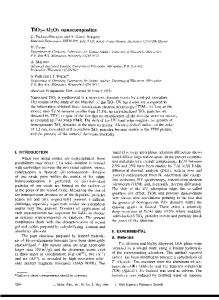Synthesis, Characterization and Bactericide Properties of Al 2 O 3 Nanoparticles and Al 2 O 3 -PAN Membranes for Alterna
- PDF / 1,890,668 Bytes
- 6 Pages / 612 x 792 pts (letter) Page_size
- 83 Downloads / 459 Views
Synthesis, Characterization and Bactericide Properties of Al2O3 Nanoparticles and Al2O3PAN Membranes for Alternative Water Disinfection Methods Abdiel Oquendo-Cruz1, Ana Vega-Avila1, and Oscar Perales-Pérez2 1 Department of Chemistry, University of Puerto Rico, Mayaguez Campus, Mayaguez, PR, USA. 2 Department of Engineering Sciences and Materials, University of Puerto Rico, Mayaguez Campus, Mayaguez, PR, USA.
ABSTRACT As the global populations grow, water demand and pollution of water resources will increase. As a consequence, water borne disease outbreaks are on the rise and current disinfection methods have been shown to be ineffective in inactivating all pathogens during water treatment. Aluminum oxide nanoparticles (Al2O3 NPs) have been shown to poses antimicrobial properties. Also, Al2O3 has high thermal and chemical stability, which makes these NPs an excellent candidate for water treatment applications. Thus, the objective of this work is to assess the bactericidal properties of Al2O3 NPs synthesized using a polyol-based process in presence of polyvinylpyrrolidone (PVP). For practical applications nanoparticles must be immobilized in a medium to ensure that particles are not dispersed into the treated water. For this reason, synthesized nanoparticles were dispersed in electrospun polyacrylonitrile (PAN) membranes to also evaluate the bacterial removal capacity. X-Ray Diffraction (XRD) and Fourier Transform Infrared Spectroscopy (FT-IR) analysis suggests that synthesized nanoparticles are γ-Al2O3 after annealing at 800˚C for 6 hours. Scanning Electron Microscopy (SEM) characterization was used to determine the morphology and size of synthesized nanoparticles. Composite electrospun membranes were also characterized by XRD, FT-IR, and SEM. The bactericide activity of the synthesized γ-Al2O3 NPs and commercially available Al2O3 particles was evaluated by the disc diffusion method against E. coli bacteria. Also, Al2O3-PAN composite electrospun membranes bacterial filtration capacity was tested. Both synthesized and industrially produced particles exhibited antibacterial activity against E. coli, but polyol-based synthesized nanoparticles demonstrated better bactericide properties. The bacterial removal capacity of PAN and PAN/Al2O3 fibers was comparable to that of paper filters. INTRODUCTION Al2O3, so-called alumina, finds many applications due to its chemical stability and excellent mechanical properties. At the nanoscale, this kind of oxide could also exhibit antibacterial properties [1,2], against gram positive and gram negative bacteria [3,4]. The bactericide capacity of the Al2O3 has been mainly attributed to the physical interaction between particles and cell wall [5] causing cell wall rupture, and the generation of reactive oxygen species (ROS), specifically singlet oxygen [6]. The aforementioned properties make the Al2O3 nanoparticles a possible candidate for water disinfection applications. Any attempt to use NPs in actual water disinfection processes, demand the NPs to be immobilized in a macroscopic ma
Data Loading...











